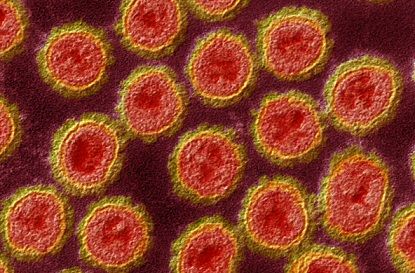U.S. NIH Study Discovers Q226L Mutation Which Enhances Binding to Human Cells in H5N1 Virus Strain Isolated in Texas
Nikhil Prasad Fact checked by:Thailand Medical News Team Dec 16, 2024 3 months, 4 weeks, 7 hours, 44 minutes ago
Medical News: Alarming Mutation in H5N1 Virus Raises Concerns About Pandemic Potential
In a groundbreaking discovery, a U.S. National Institutes of Health (NIH)-funded study has identified a specific genetic mutation in the H5N1 avian influenza virus that enhances its ability to bind to human cells. This finding, centered around the Q226L mutation, was observed in a strain of the virus isolated from the first human infection linked to dairy cows in Texas in 2024. Researchers from The Scripps Research Institute, California, and collaborating institutions warn that such genetic changes could signal an increased risk of human-to-human transmission, raising concerns about potential pandemic threats.
 U.S. NIH Study Discovers Q226L Mutation Which Enhances Binding to Human
U.S. NIH Study Discovers Q226L Mutation Which Enhances Binding to Human
Cells in H5N1 Virus Strain Isolated in Texas
The study, which delves into the molecular mechanics of the highly pathogenic avian influenza (HPAI) H5N1 virus, sheds light on the mutation's role in switching receptor specificity from avian to human cells. The Q226L mutation in the virus's hemagglutinin (HA) protein, which plays a critical role in how influenza viruses attach to host cells, was found to enhance binding to receptors commonly found in human respiratory systems. While the findings do not suggest an immediate pandemic, they underscore the need for heightened surveillance of emerging influenza strains.
What Is the Q226L Mutation, and Why Does It Matter?
Influenza viruses, including H5N1, rely on hemagglutinin (HA) proteins to attach to host cells, a process critical for initiating infections. These proteins recognize sugar molecules called receptors on the cell surface. Avian influenza viruses typically target "avian-type" receptors, predominantly found in birds, which limits their ability to infect humans. However, human respiratory tracts harbor "human-type" receptors, making receptor specificity a key determinant of whether the virus can jump between species.
In this
Medical News report, we delve into how scientists explored this mutation. The NIH-funded team focused on a bovine-origin H5N1 virus strain, A/Texas/37/2024, associated with infections in dairy herds and sporadic human cases in Texas. By introducing specific mutations into the HA protein in laboratory settings, researchers discovered that the Q226L mutation alone enabled the virus to bind more effectively to human-type receptors. Furthermore, when paired with additional mutations, such as Asn224Lys, the binding efficiency increased, further highlighting its potential significance.
The Study's Methodology and Key Findings
The researchers employed advanced techniques such as surface plasmon resonance (SPR), enzyme-linked immunosorbent assays (ELISA), and glycan array analyses to assess the binding affinities of the HA protein. They also utilized X-ray crystallography to examine the structural changes in the HA protein resulting from the Q226L mutation. The experiments revealed:
t;-Enhanced Binding to Human-Type Receptors: The Q226L mutation facilitated a complete switch in receptor specificity, allowing the virus to bind more strongly to human-type receptors while losing its affinity for avian-type receptors.
-Structural Basis for Binding Shift: Structural analyses showed that the substitution of glutamine with leucine at position 226 altered the HA protein's receptor-binding site, creating a better fit for human-type receptors.
-Synergistic Effects of Additional Mutations: When combined with mutations like Asn224Lys, the Q226L mutation amplified receptor-binding strength, potentially increasing the likelihood of human adaptation.
Importantly, these experiments were conducted in highly controlled laboratory environments, using isolated HA proteins rather than complete, infectious viruses, to ensure safety.
Broader Implications for Public Health
While the current risk of human-to-human transmission of this H5N1 strain remains low, the findings are a sobering reminder of how influenza viruses can evolve. Historically, receptor specificity changes have played pivotal roles in influenza pandemics, including the infamous 1918 Spanish Flu and the 2009 H1N1 "swine flu" outbreak.
The study emphasizes the importance of continuous genomic surveillance, particularly as H5N1 continues to circulate widely among avian species, mammals, and even humans. Since 2021, the clade 2.3.4.4b strain of H5N1 has become increasingly prevalent in North America, affecting poultry, wild birds, marine mammals, and dairy cows. Human cases, though rare, have raised alarms, with the U.S. Centers for Disease Control and Prevention (CDC) reporting multiple infections tied to direct contact with infected animals.
Why Surveillance Is Crucial
The Texas outbreak marked the first known cases of H5N1 infection in dairy cattle, expanding the virus's host range. This development adds a new layer of complexity to controlling its spread. Dairy workers and others exposed to infected animals could unknowingly serve as a bridge for the virus to adapt to human hosts. The study underscores that even a single mutation, like Q226L, can significantly alter the virus's behavior, making constant monitoring essential to preempt a potential health crisis.
Conclusions: A Call to Action
The discovery of the Q226L mutation serves as a stark reminder of the ever-present threat posed by zoonotic viruses, particularly influenza strains capable of crossing species barriers. While the immediate risk of a human-to-human transmissible H5N1 strain remains low, the findings highlight the virus's potential to adapt through natural genetic changes.
As researchers continue to unravel the mechanisms underlying influenza evolution, public health agencies must remain vigilant. Strengthened surveillance, targeted vaccination efforts, and global collaboration are key to mitigating the risks associated with emerging influenza strains. Additionally, the study calls for increased investment in pandemic preparedness, including the development of vaccines and antiviral drugs tailored to high-risk influenza subtypes.
The study findings were published in the peer-reviewed journal: Science.
https://www.science.org/doi/10.1126/science.adt0180
For the latest H5N1 News, keep on logging to Thailand Medical News.
Read Also:
https://www.thailandmedical.news/news/reassorted-strain-of-h5n1-bird-flu-virus-discovered-in-cambodia
https://www.thailandmedical.news/news/h5n1-bird-flu-adaptation-in-cats-in-south-dakota-as-a-lethal-neurotrophic-virus-raises-alarms
https://www.thailandmedical.news/news/new-evolution-of-avian-influenza-h5n1-a-growing-threat-in-the-usa-and-beyond
https://www.thailandmedical.news/articles/h5n1-avian-flu
